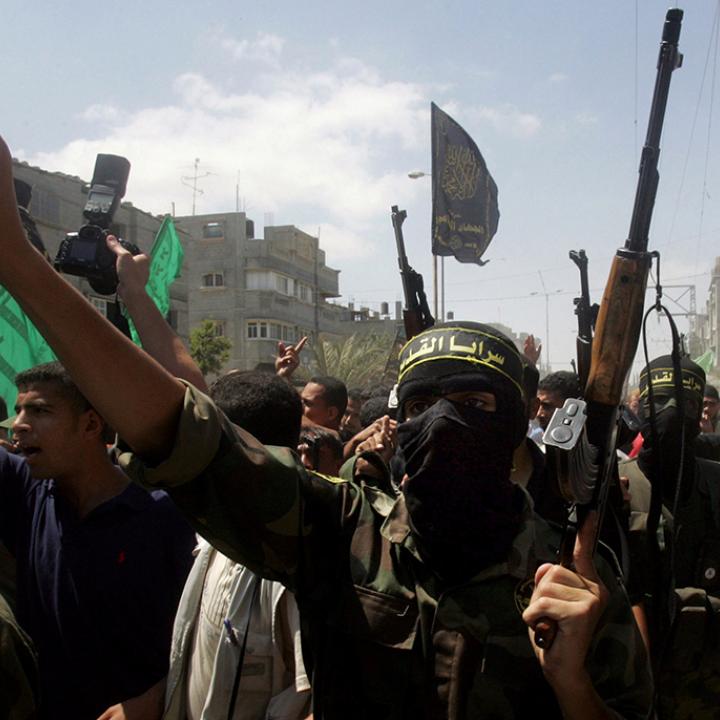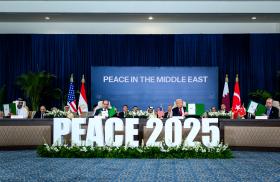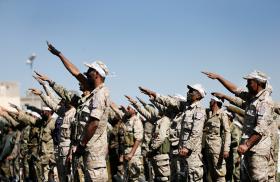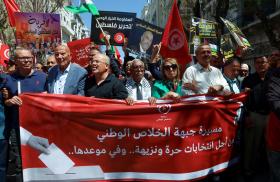
- Policy Analysis
- PolicyWatch 4122
“Deradicalization” in Gaza: The Problem, the Solution, and the Measures of Success

To ensure the U.S. peace plan meets the long-term goal of a Gaza that is not ruled by Hamas and does not pose a threat to its neighbors, authorities need to combine realistic and measurable achievements with efforts toward disarmament, civilian reconstruction, and changing the public agenda.
President Trump’s twenty-point plan for ending the Gaza war begins by stating that the goal is to transform the Strip into “a deradicalized terror-free zone that does not pose a threat to its neighbors.” Yet the bulk of the proposal focuses on ceasefire terms and subsequent political, military, and economic arrangements between the parties. As it currently stands, the plan does not clearly define what “deradicalization” entails, nor does it offer a strategy for dismantling Hamas’s ideological and institutional influence after nearly two decades of rule. It also fails to address the social, educational, and cultural drivers of violent extremism in a substantive way.
Therefore, the first step must be to redefine the concept of “deradicalization,” shifting from an abstract and complex objective to a more realistic and actionable goal: reducing public motivation to support Hamas or participate in acts of terrorism. This reframing would allow for the establishment of measurable benchmarks, enabling policymakers to track progress, evaluate successes, and address setbacks in a systematic manner. Within this framework, efforts should focus on creating the economic, social, and political conditions necessary to support such a transformation—conditions that reduce the appeal of terrorism and diminish the incentives for young Palestinians to join or endorse Hamas’s violent activities.
Deradicalization or Disengagement?
Most academic research on deradicalizing terrorist operatives and supporters emphasizes the need for ideological and normative change within individuals, alongside behavioral transformation to end violence. Yet there is no agreed formula for the depth of ideological change required, and measuring success in a task that centers on altering individual beliefs is extremely hard, if not impossible.
Recognizing this difficulty, most scholars distinguish between cognitive deradicalization (i.e., rejecting the ideology that legitimizes terrorist violence) and behavioral disengagement (refraining from such violence). They argue that full ideological transformation is rarely achievable and often unnecessary. In many cases, adopting a more pragmatic version of extremist ideology—one that rejects violence for utilitarian reasons—may suffice.
Lessons from Elsewhere
Experiences from other locales offer mixed insights on using deradicalization programs to help address violent extremism, particularly in a postwar stabilization scenario like present-day Gaza. For example, Yemen’s Al-Hitar program and Saudi Arabia’s rehabilitation initiatives, each launched in the early 2000s, relied on religious dialogue and reeducation. Yet while both programs showed short-term promise, they struggled to produce lasting ideological change; success was often measured by recidivism rates, which initially declined but later rose, raising doubts about long-term effectiveness.
In contrast, denazification efforts in postwar Germany demonstrated the efficacy of more pragmatic measures such as establishing a neutral external governing authority, facilitating broad economic recovery, dismantling the previous regime’s institutions, carrying out educational and media reforms, and creating a credible political horizon. Moreover, U.S.-led postwar efforts in Afghanistan and Iraq highlighted the need for local ownership of the process to avoid perceptions of foreign imposition. Research emphasizes that targeted rehabilitation of youths formerly involved in extremist groups is important—but so are efforts to address the underlying grievances that radical ideologies exploit, such as poverty, corruption, and discrimination.
Taken together, these examples suggest that beyond removing Hamas from power, postwar programming in Gaza should focus on disengagement rather than deradicalization—that is, creating a reality in which returning to violence is no longer in the interest of those who previously engaged in it. To succeed, such efforts must be led by local actors who bring a new and distinct agenda—a viable alternative to Hamas—and must include significant investment in socioeconomic recovery, institutional reform, and a clear political path that offers genuine hope for the future.
Next Steps for Gaza
Experiences from partial successes in disengagement—whether from Nazism or violent Islamism—underscore the need for a multilayered approach that goes beyond targeting individual extremists to address the broader social, political, and communal ecosystems in which radicalization takes root. As researcher Audrey Kurth Cronin has argued, successful disengagement in Gaza will entail shifting the cost-benefit calculus of Hamas supporters and, to a lesser extent, Hamas operatives. The first step in this process is establishing a governance alternative that is more effective, legitimate, and attractive than Hamas in the eyes of the public. Authorities can then turn to offering members of the group—men and women alike—a dignified personal life outside the organization, embedded within a supportive social framework.
To be clear, disengagement efforts cannot succeed in isolation—their effectiveness depends on synchronized political, economic, and social processes. In Gaza, this means coordinating between external actors with often-divergent interests and priorities. For example, Israel will presumably make dismantling Hamas’s military infrastructure and demilitarizing Gaza a prerequisite for reconstruction, while other actors will emphasize the importance of a clear political horizon to build public trust and foster disengagement. Disagreements may also arise over the role of certain international organizations and countries—for example, Israel views the UN Relief and Works Agency, Qatar, and Turkey with skepticism, but the U.S. government and others consider some of these actors essential to reconstruction and deradicalization.
In coordinating an allied strategy for disengagement programming in Gaza, the United States should prioritize the following four pillars:
Security disengagement. Fully dismantling Hamas’s military capabilities is imperative, including systematic confiscation of weapons from members of the group and other armed factions under international supervision, alongside civilian incentives to prevent rearmament. A wide selection of literature on disarmament, demobilization, and reintegration (DDR) should be consulted to ensure success, coupled with the UN’s practical implementation of these concepts in multiple conflict zones. Specific steps in this process should include establishing centralized weapon collection sites, deploying vetted and trained Palestinian security forces, enacting legislation that enshrines the principle of “one authority, one law, one gun,” and gradually restoring civil infrastructure. In parallel, border controls and monitoring mechanisms—especially along the Egypt-Gaza frontier—should be implemented to prevent weapons smuggling and strengthen public trust in the demilitarization process. Intelligence-led operations to locate hidden weapons stockpiles and tunnel networks will also be crucial, as will legal reforms that criminalize unauthorized armed groups and ensure long-term enforcement.
Territorial and institutional disengagement. Demilitarizing Hamas also depends on dismantling its governance, security, and communication infrastructure in Gaza. The first major step in this effort is to distinguish between Hamas combatants with military roles and civilian employees who received salaries from the organization. Combatants must undergo disarmament and, if necessary, detention or participation in disengagement programs. Yet civilian employees not involved in violence (e.g., teachers, healthcare workers) may be reintegrated more quickly through civil rehabilitation programs, subject to security screening. In all cases, reintegration should be supported with economic assistance, vocational training, and psychosocial support.
Second, authorities should shut down Hamas-controlled media channels, establish an independent communication authority under international supervision, and initiate efforts to reform religious and educational content. Intelligence operations should be launched to locate the infrastructure that enables organized incitement, and Palestinian legislation should aim to ban extremist messaging. The technocratic, apolitical Palestinian committee proposed in the twenty-point plan—supported by international actors such as Tony Blair—can serve as a suitable framework for managing reliable civilian communication, integrating local and international experts, and ensuring the flow of information free from radical influence. At the same time, foreign governments should be expected to provide guarantees that they will not platform Hamas, ensuring that the new transitional authority has a monopoly on governance, security, and communication.
Civil-social reconstruction. To erode public support for extremism and lay the groundwork for legitimate governance, reconstruction must extend beyond basic services and security, to include dismantling Hamas’s influence inside state institutions, building a fair economy, and establishing an independent judiciary. In the immediate term, flooding Gaza with humanitarian aid is crucial to break the group’s grip on the black market, but the focus must quickly shift to stabilization: namely, investments in infrastructure, employment, education, and civil society.
To be sure, the process of purging Hamas from governance institutions will be measured in months or years, not weeks, depending on international coordination, local support, and the presence of a credible transitional authority. It must be gradual, starting with the most vulnerable sectors and expanding to the judiciary and security apparatus. Without that, there will be no foundation for real change.
Agenda transformation. Ultimately, there must be a concerted effort to reshape the public agenda of Gaza’s population. The primary focus should be on reducing public motivation to support Hamas or participate in future acts of terrorism initiated by it or other militant organizations. An alternative leadership—composed of credible local figures—should work to promote the values of reconciliation, human rights, and rule of law. A reality in which reconstruction, personal security, and social welfare are at the center of public life can help foster a new language of hope, belonging, and forward-looking purpose.
International experience in countering the Islamic State has shown that effective narratives are not built on fear, but on identity and meaning. To dismantle toxic ideologies, it is not enough to refute them—the United States and its partners must offer a more compelling alternative. In Gaza’s case, metrics for success should focus on the public’s willingness to support a governing alternative to Hamas, their readiness to engage in reconstruction and demilitarization efforts, and their parallel refusal to assist Hamas in rebuilding its military capabilities or recruiting new members.
Saudi Arabia and the United Arab Emirates may be uniquely positioned to lead this transformation, leveraging their broad regional legitimacy, robust media infrastructure, and proven experience in countering extremism. It is especially important that these programs emphasize universal values rather than religious reeducation. Patience will also be essential—deep agenda transformation is a long-term process that demands persistence and coordinated action across multiple systems. Only a sharp, consistent, multilayered approach can drive meaningful change and lay the foundation for a stable post-Hamas Gaza.
Neomi Neumann is an adjunct fellow with The Washington Institute and former head of the research unit at the Israel Security Agency. Devorah Margolin is the Institute’s Blumenstein-Rosenbloom Senior Fellow and an adjunct professor at Georgetown University.



